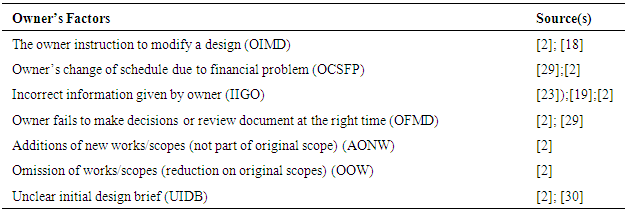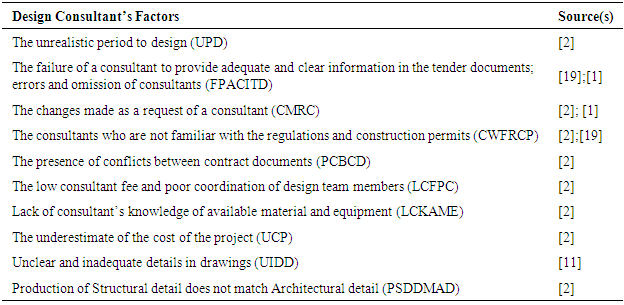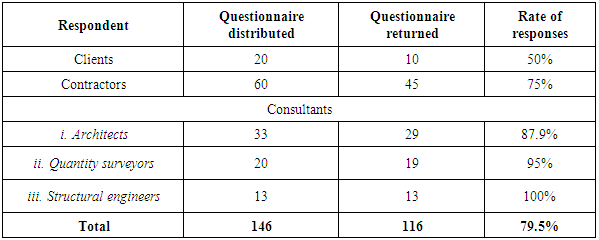-
Paper Information
- Paper Submission
-
Journal Information
- About This Journal
- Editorial Board
- Current Issue
- Archive
- Author Guidelines
- Contact Us
International Journal of Construction Engineering and Management
p-ISSN: 2326-1080 e-ISSN: 2326-1102
2016; 5(4): 93-101
doi:10.5923/j.ijcem.20160504.01

Factors Influencing Change of Design of Building Projects during Construction Stage in Dar-es- Salaam Tanzania
Iliyas J. Suleiman, Valentine G. M. Luvara
Building Economics, Ardhi University, Dar es Salaam, Tanzania
Correspondence to: Valentine G. M. Luvara, Building Economics, Ardhi University, Dar es Salaam, Tanzania.
| Email: |  |
Copyright © 2016 Scientific & Academic Publishing. All Rights Reserved.
This work is licensed under the Creative Commons Attribution International License (CC BY).
http://creativecommons.org/licenses/by/4.0/

The construction industry involves different stages that are followed for the building projects to be executed. Designing is one among the stages involved. What is expected to be executed is what had been designed but things may be different from this expectation. The objective of this research is to analyze the factors that lead to change of design and their effects during construction stage of building projects in Dar es Salaam, Tanzania. This research employed survey as a methodology where data collection was done through questionnaires which were distributed to different parties in construction which included clients, building contractors and consulting firms. The analysis of the study was done by using SPSS version 20 where by eventually the factors of change of design during construction stage and their effects were analyzed. The results identified different factors that lead to change of design during construction stage such as owner’s factors, design consultant factors, managing consultant factors, contractor’s factors, environmental factors, political and economic factors and third parties’ factors. Also the results identified the effects that affect the overall performance of the building projects such as delay of the projects, increasing of cost of the projects, abandoning of the projects, wastage of materials and conflicts between the parties. The results recommend proper implementation of feasibility study before design, effective involvement of the parties during design stage, provision of clear brief by the client, provision of proper time for designing, ensure sufficient budget for the project, undertaking detailed underground investigation, design team should check for perfect design, proper supervision for both consultant and contractor and involvement of end users before starting of the construction.
Keywords: Change of design, Building projects, Construction stage, Tanzania
Cite this paper: Iliyas J. Suleiman, Valentine G. M. Luvara, Factors Influencing Change of Design of Building Projects during Construction Stage in Dar-es- Salaam Tanzania, International Journal of Construction Engineering and Management , Vol. 5 No. 4, 2016, pp. 93-101. doi: 10.5923/j.ijcem.20160504.01.
Article Outline
1. Introduction
- The construction industry in general is accompanied by the changes of different aspects in it in such a way some are inevitable. There are different factors that lead to change of design during construction stage some of which lead to cause problems to the overall performance of building construction project [9]. Changes in design are frequent in many projects in which construction starts before the design is finalized. Such changes affect the project in various ways depending on the timing of the change [14]. As [3] put forward, construction projects are more difficult to manage because of uncertainty factors inherent in the projects. The uncertainty of the projects is reflected in the difficulty of obtaining design information during the design process. As a result, most projects end up with high amounts of design changes during construction stage.There are different researchers whose research output found that change of design of building projects cause negative impact in building construction. For example the research done by [22] which based on assessing the causes and effects of delays and disruptions in construction projects in Tanzania, found the main causes as: design changes, delays in payment to contractors, information delays, funding problems, poor project management, compensation issues and disagreement on the valuation of work done.Although it was portrayed by [22] that, the design change was one of the major causes that affecting performance and causing disruptions in construction projects in Tanzania, but what influenced occurrence of these changes of design were not discussed.The aim of this research is to find out why these changes occur while there are design teams in building construction design. Also what are the effects of these changes in building projects? Many building construction projects that take place in Tanzania are subjected to change of design while in the course of execution and the consultant teams are changing the design more than one time.
2. Change of Design in Construction
- The design process is a process that is performed in a series of iterative steps to conceive, describe and justify increasingly detailed solutions to meet the needs of the client [7]. Even though these changes are inevitable to occur as explained by Chronicle in his research [9] but the problem is the frequency and major changes involved that at the end affect the overall performance of building construction projects [9].In construction projects, a change refers to an alteration or a modification to pre-existing conditions, assumptions and basic information, or requirements. It includes work, time, cost and method of performance [15]. It is described by [19] that building design is the process of providing all information necessary for construction of a building that meet its owner’s requirements and also satisfy public health, welfare, and safety requirements. Building design may be legally executed only by persons deemed competent to do so by the state in which the building is to be constructed. Competency is determined on the basis of education, experience, and ability to pass a written test of design skills.In the work by [8], design change is defined as any change to the scope of the work as defined by the contract documents following the creation of legal relations between the principal and the contractor. Often the changes are no fault of the contractors. Design changes may occur in architectural, structural, plumbing and drainage, site works or other aspects of construction.According to [20], there are different members that contribute to change of the design during the design and construction phase of building construction projects. The following are players that cause change of design during construction stage of building projects: The contractor (main contractor or subcontractor), the design team (including architect, service engineers, structural engineers, etc) and the client/employer himself.
2.1. Building Project Stages
- There are six stages of design and construction of the construction projects [5]. However, on some projects, several of these steps may be combined or there may be additional ones. These phases are:
2.1.1. Conceptual Design
- It is the first stage where by the client/employer and the architect sit and discuss on the requirements of the project For example how many rooms are needed and what are the functions of the spaces. Also the fitness between the owner’s needs, wants and budget are tested [5].
2.1.2. Schematic Design
- It is the stage where by the architects give graphic shape to the owner’s program. It goes through several revisions, because the first design proposals prepared by the architects are rarely being approved by the owner. The architects communicate the design proposal to the owner including plans, elevations, sections, freehand sketches, and three-dimensional graphics [25].
2.1.3. Design Development
- It is the stage in which the architect and the specialty consultants prepare design development documents to define further the size and character of the project. It includes architectural, civil, structural, mechanical, and electrical systems, materials, specialty systems, interior development, and other such project components that can be used as a basis for working drawing development [19].
2.1.4. Construction Documentation
- At this stage inclusion involves preparation of construction documents such as drawings and specifications as well as preparation of the documents for bidding process [19].
2.1.5. Construction Bidding
- At this stage, the drawings and other bidding documents prepared during construction documentation stage are used in finding the competent contractor and when the contractor is procured, negotiation follows before awarding the contract [32].
2.1.6. Construction Administration
- It is the process whereby the Construction Manager or contactor in general, working together with the architect who acts as client/employer’s agent to oversee construction to ensure conformity to construction drawings, specifications, and standards [32]. In spite of the fact that there are five phases before construction starts (construction administration), change of design during the construction is much observed to affect the general overall performance of the building projects.
2.2. Factors Influencing Change of Design
- Changes of design in construction can be caused by various sources at different stages of the work, moreover in this context the focus is during construction stage. The cause of change may originate from external or internal issues that may occur during the development phases of project i.e from basic design to construction [15].The following identified factors are part of literature review on factors leading to change of design during construction stage happening elsewhere in the world. The detailed review has resulted in identifying 42 common factors (30 are internal factors and 12 are external factors) that influence the change of design during construction. These factors were strongly considered for further investigation to find significance, occurrence and relevance toward the Tanzania construction industry. The identified factors are divided into seven groups which are owner’s factors, design consultant factors, managing consultant factors, contractor’s factors, political and economic factors, environmental factors and third parties factors.
2.2.1. Internal Factors
- The following are internal factors that lead to change of design during construction stage as shown in Table 1 to Table 4.
|
|
|
|
2.2.2. External Factors
- Table 5, Table 6 and Table 7 shows the external factors that lead to change of design during construction stage.
|
|
|
3. Methodology
- The methods used to collect the data for this research were questionnaire and interview. The questionnaires were prepared in accordance with objectives of the research. The questionnaire was divided into two parts; first part requested on general information about respondent, second part focused on factors that contribute to change of design during construction. The factors causing to change of design categorized into two categories which are internal and external factors. The data used were obtained through questionnaire and interview.
3.1. Questionnaire Design
- This study investigated the factors influencing change of design in building projects of Tanzania. The investigation considered the building clients, consultants and building contractors (Architects, Quantity Surveyors and Engineers). Factors were gathered based on literature review. Through a quantitative approach, data used were acquired with a questionnaire survey. The questionnaire was compiled based on the refined list of factors causing design changes after a pilot study. The pilot was carried out to mark better the quality of the questionnaire and improve reliability of the questions. Closed-ended questions were used as they are very convenient for collecting factual data and are simpler to analyze because the range of potential answers is limited [13, 4]. The respondents were asked to provide their views on the most influencing factors using a 5-point Likert scale. In a Likert scale, the respondent is asked to respond to each of the statements in terms of several degrees, normally five degrees [23]. The ratings used were: Totally disagree = 1; Partially disagree = 2; Indifferent = 3; Partially agree = 4; and Totally agree = 5. This type of scale has been found to be acceptable in other construction management research. For example, [21] used a similar approach to construct a success measurement model for construction projects.
3.2. Data Collection
- In general the data collection process through this method had been quite good. Multiple sources of evidence were used to collect data. Literature was reviewed to identify factors causing change in design of building projects. Questionnaires survey was used to collect primary data from clients, consultants and building contractors. The questions were on seeking factors influencing design change as well as to uncover their effects on building projects. All respondents had experience of more than 10 years in the construction industry which indicate that most of respondents are familiar with management of building projects.
3.3. Response to Questionnaires
- This study consisted of questionnaires that required information from different respondents including clients, architects, quantity surveyors and engineers from consultant firms and building contractors.A total of 146 questionnaires were distributed and 116 of them were returned. This response amount to 79.5% which was used to represent the targeted sample in the study. The analyses of the data collected from this study was done through the software program of SPSS version 20. The summary of these responses is shown in the Table 8 below showing the percentage of respondent.
|
4. Results and Discussion
- The data collected for this study were analyzed by using the Statistical Package for Social Science (SPSS) 20.0 package. The data collected from the questionnaire were coded and entered into the software to calculate the required statistics, including the mean, standard deviation and variance. The mean ratings, variance and coefficients of variations of the data were calculated by using the following formulae
 | (1) |
 | (2) |
 | (3) |
 | Table 9. Factors Influencing Change of Design of Buildings during Construction Stage |
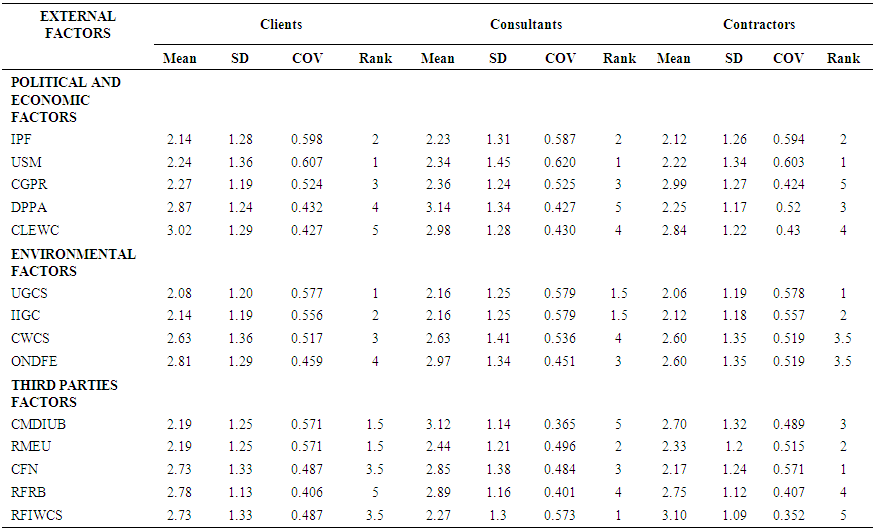 | Table 10. Factors Influencing Change of Design of Buildings during Construction Stage |
4.1. Effects of Change of Design during Construction
- The study also managed to find out different effects that are related to change of design during construction stage. These effects are:
4.1.1. Delay of the Projects
- It was found that when there is change of the design during construction, project completion period increases. This is because, designing of the new changes of design in structural, services and architectural would require the enough time, approval of the new drawings will use time as well as appraisal of the new materials will need time. Hence at the end the project duration will be increased.
4.1.2. Change of cost of the Project
- When design changes occur during construction stage, there is a tendency of the cost of the project to change. The injection of more money will be required if the design changes are complex or increase the project scope. As such, some of the changes require new items that can be more expensive that first proposed ones, also the are some of the extra cost that would be resulted due to extension of the time.
4.1.3. Abandoning of the Project
- Changing of the design during construction may lead to abandoning of the projects, this may happen in a situation where the design changes have increased the cost and client fails to afford the extra cost to complete the project. Some of the project will be stopped for more than year just waiting for client to have enough money so as to complete the project while some might be abandoned.
4.1.4. Wastage of Materials
- Some changes of the design during construction are related to the wastage of materials. This will happen in circumstances where design changes compel some areas of the already constructed elements of the building structure to be demolished.
4.1.5. Conflicts between the Parties
- Also change of the design during construction may result into the conflicts between members of the project. This may happen especially when the design is at fault and the constructor has proposed changes to facilitate constructability. In such a case by any circumstance if such changes increase the cost of construction, the client might wrangle with the consultant for such an incompetent initial design that makes the client incur extra cost and disturb the budget.
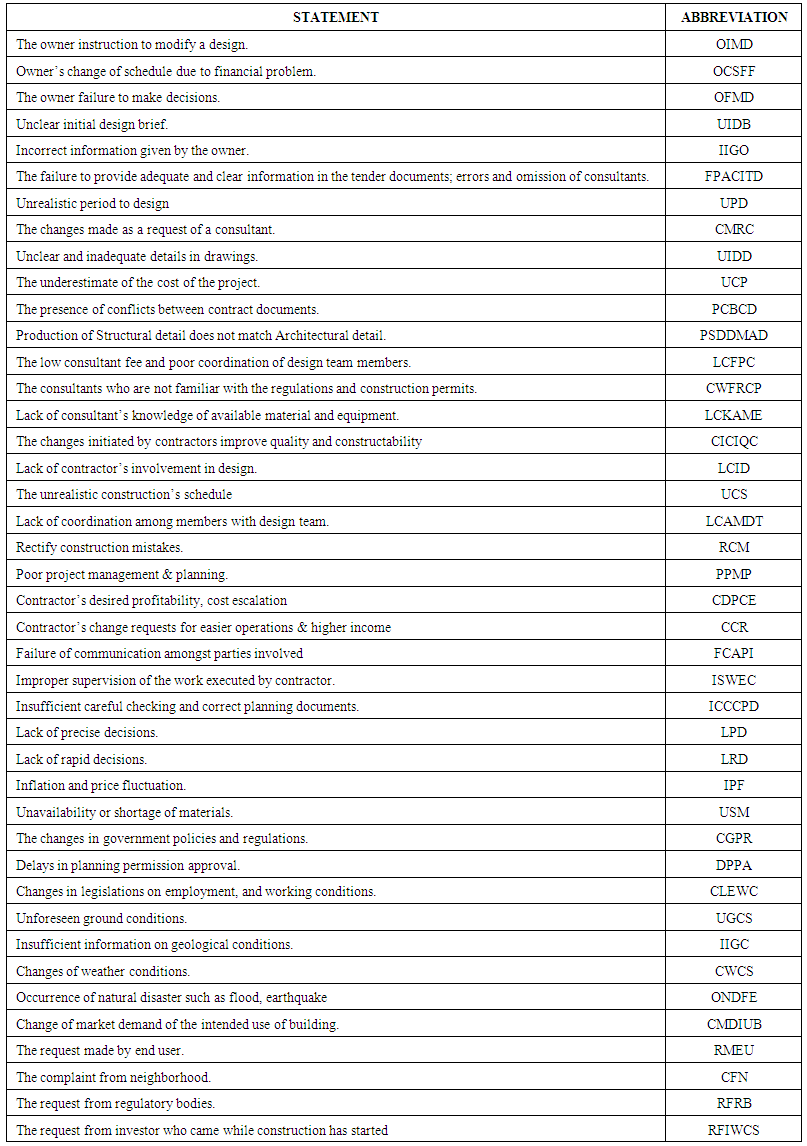 | Table 11. List of Abbreviations of the Factors |
5. Conclusions and Recommendations
- This research investigated on factors influencing to change of design during construction stage in building construction projects in Tanzania, their effects on projects and controls measures. The study concludes that there still exist a number of factors leading to change of design during construction stage for the building construction projects executed in Tanzania. These factors including: Internal factors which are client factors, managing consultant factors, design consultant factors and contractor’s factors. External factors are political and economic factors, third parties factors and environmental factors.For the case of Tanzania, the client’s factors and design consultant factors have more influence in change of design during construction stage for internal factors and the environmental factors found to have large influence to change of design followed by the third parties factors for external factors.The most common effects for those projects that change of design took place during construction stage were delay of the projects, increasing of cost of the project (cost overrun), abandoning of the project, wastage of materials and conflicts between the parties.Finally, the study provides different measures that should be taken so as to minimize occurrence of the unnecessary change of design during construction. These measures are: ensure proper feasibility study before design, ensure effective involvement of the parties during design stage, provision of clear brief by the client, provision of proper time for designing, ensure sufficient budget for the project, involvement of experienced technical personnel, undertaking detailed underground investigation, design team should check for perfect design, involvement of end users before starting of the construction and proper supervision for both consultant and contractor. It is also concluded that the good performance and success of a building construction project, to a large extent, is determined by the ability and effectiveness of the project team to manage the unnecessary changes during the project.
 Abstract
Abstract Reference
Reference Full-Text PDF
Full-Text PDF Full-text HTML
Full-text HTML